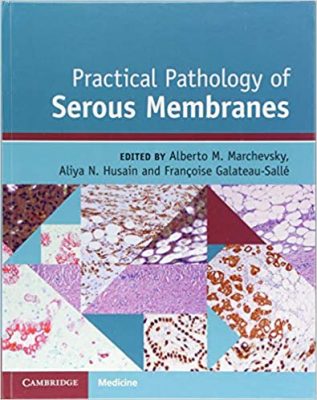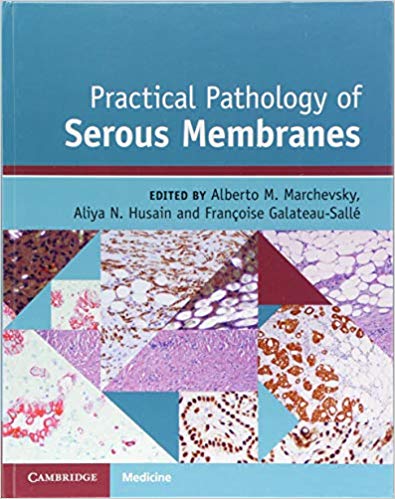 Editors: Alberto M. Marchevsky, Aliya N. Husain and Frncoise4 Gallateau-Salle
Editors: Alberto M. Marchevsky, Aliya N. Husain and Frncoise4 Gallateau-Salle
Publisher: Cambridge University Press – 234 -ages
Book Review by: Sonu Chandiram
A serous membrane, also referred to as a serosa, is one of the thin membranes that cover the walls and some organs of the thoracic and abdomino-pelvic cavities. The most common of these organs are the lungs. One of the common pathologies affecting the lung is mesothelioma.
Mesothelioma is a type of cancer that develops from the thin layer of tissue that covers the lungs also known as the mesothelium. The most common area affected is the lining of the lungs and chest wall. The inhalation of asbestos particles is one of the most common causes of mesothelioma.
The mesothelioma death rate in the United States from 1999 to 2015 was around 8 deaths per million people, according to a 2017 report from the U.S. Centers for Disease Control and Prevention. During that time period, a total of 45,221 deaths from malignant mesothelioma were reported in the U.S.
Twenty-six specialists in laboratory medicine, pathology, and radiology from all over the United Sates and three other countries – France, Spain, and the United Kingdom – authored the 16 chapters of this book, namely:
- The Mesothelium – Embryology, Anatomy, and Biology
- Classification of Neoplastic and Non-neoplastic Lesions of ther Serosal Surfaces
- Multi-modality Imaging of Pleural and Peritoneal Disease
- Processing of Pleural and Peritoneal Pathologic Specimens for the Diagnosis of Mesothelioma
- Cytology of Pleural and Peritoneal Lesions
- Surgical Pathology of Non-neoplastic conditions of Pleura, Pericardium, and Peritoneum
- Surgical Pathology of Benign Lesions of Mesothelial Origin
- Epidemiology, Etiology and Pathogenesis of Malignant Mesothelioma
- Pathologic “Markers” of Above Background Asbestos Exposure
- Molecular Aspects of Malignant Mesothelioma and Other Tumors of the Pleura and Peritoneum
- Pathology of Malignant Mesothelioma
- Surgical Treatment of Pleural and Peritoneal Mesothelioma
- Non-surgical Treatment of Malignant Mesothelioma
- Primary Carcinoma of the Pleura and Peritoneum
- Lymphoid Malignancies of the Pleura and Peritoneum
- Mesenchymal and Other Unusual Tumors of the Pleura and Peritoneum
For online resources, go to www.Cambridge.org/core
The pleura, peritoneum, and pericardium are three of the common serous membranes in the body where a large number of malignant and non-malignant conditions can occur.
The pleura is a serous membrane which folds back onto itself to form a two-layered membranous pleural sac. The outer pleura (parietal pleura) is attached to the chest wall, but is separated from it by the endothoracic fascia.
The peritoneum is one continuous sheet, forming two layers and a potential space between them: the peritoneal cavity. The outer layer, the parietal peritoneum, is attached to the abdominal wall and the pelvic walls.
The pericardium is a double-walled sac containing the heart and the roots of the great vessels. The pericardial sac has two layers, a serous layer and a fibrous layer. It encloses the pericardial cavity which contains pericardial fluid.
What makes this book important is that there only a few books that provide an updated review of the lesions that affect these membranes. This book provides a comprehensive yet concise review of the embryology, anatomy, and other aspects f diagnosing and treating conditions found in serous membranes, as shown in the above list of chapters. In this book you will also see images of various lesions, as well as their classification as done by the World Health Organization in 2015.
The initial chapter describes the embryology, anatomy and selected aspects of the biology of serous membranes such as the pleura, peritoneum, and pericardium. The second chapter lays out the WHO classification of neoplastic and non-neoplastic lesions of serosal surfaces. This is followed by two chapters that describe the various methods presently used to diagnose malignant mesothelioma and other lesions on biopsy specimens and cytological specimens. What follows in this book can be gleaned from the titles of the chapters we have laid out above for you.
This is a great book that is tightly focused on the diagnosis and treatment of disorders and diseases that occur on the thin membranes that cover various organs of the human body.
Editors:
Alberto M. Marchevsky, MD is Director of Pulmonary and Mediastinal Pathology in the Department of Pathology and Laboratory Medicine at Cedars-Sinai Medical Center in Los Angeles, and a Clinical Professor of Pathology at David Geffen School of Medicine at the University of California in Los Angeles (UCLA).
Aliya N. Husain, MD is Professor of Pathology and Director of the Thoracic Pathology Fellowship at the University of Chicago in Chicago, Illinois.
Frncoise Gallateau-Salle, MD is Professor of Pathology in the Department of Biopathology Cancer Center at Leon Berard Lyon in France, Chairman of the International Mesothelioma Panel and MESOPATH Reference Center, and Manager of the French National Multicenter MESOBANK.







